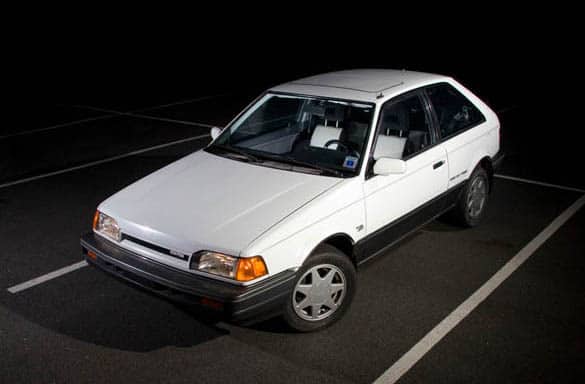I was originally going to finish up the rest of the 323GTX adventure but driving the Mazdaspeed 3 made me change my mind. I decided to do a comparison of the Mazda turbo hatchbacks. Driving the Mazdaspeed 3 for a week the car is really making me consider getting rid of the other cars I own. As I drove my 323 GTX to work today for a change, getting into an older car really makes you appreciate the refinement Mazda has put into the new Mazdaspeed 3.
Consider the following, in late1987 when the 323 GTX was new Mazda sold the car for around 16k. Back in 1988 that was a lot of money for a sporty hatchback. The 323 GTX was the most advanced hatchback you could purchase at the time from Mazda. Jump forward 20 years and Mazda decided to go all in on the hotrod hatch market again with the Mazdaspeed 3. Granted the 2010 model is the refined version and so was the 323GTX when it was introduced to North America. Little known to some people the 323 GTX had gone through a facelift and revisions from the 1986-87 models to the version we received in 1988. 20 years is a long time in car production so now I will get to the comparison.
Note: the 323GTX used in this comparison has been modified in about every way possible. The modifications of the 323 give it a chance against the Mazdaspeed 3 in terms of power and handling despite the 20 year gap in production.
The 323GTX is very coarse in all aspects of the engine. The boost hits very fast with lots of exhaust noise and the Greddy BOV venting between shifts. The shifts come up fast too, as the gearing is very short in the transmission. The Mazdaspeed 3 in comparison the power comes up fast but it is much smoother. I can give the car some throttle and not worry about the exhaust volume or the venting BOV waking up the neighbors on the way to work at 6am. (I like my neighbors so I short shift it and keep the rpm low. If you don’t like your neighbors ask me to take the long way to work some morning through your neighborhood)
The Mazdas are pretty close in terms of acceleration. The 323GTX would take the Mazdaspeed 3 off the line due to the AWD advantage and lighter weight but once you are moving the Mazdaspeed 3 is faster with a higher top speed.
Handling is really close in terms of grip but the Mazdaspeed 3 handles with less steering effort. I took some local customers for a ride in the car and we left the off ramp on the merge lane to I205 about 10 miles an hour faster than I feel comfortable doing in my 323 with just me in the car. I had an uneven load of weight in the Mazdaspeed 3 and the car still felt more secure with the extra 175lbs on the driver’s side in the back seat.
The brakes are really no comparison. The 323GTX did not get the brakes a car like that needed. The Mazdaspeed 3 on the other hand has massive brakes.
You can tell Mazda spent some time on the interiors of both cars. The 323 GTX had some of the best production seats ever made in terms of support and comfort. The Mazdaspeed 3 seats are just as good but will be more durable with leather bolsters. The Mazdaspeed 3 really shines in terms of how quiet the interior is. You can drive the car fast and not drown out the screams of the passengers crying “I’m gonna die” in an effort to get you to slow down or not take the next corner as fast. The layout of the new dash and all of the switch gear placed better and more intuitive compared to the 20 year old 323GTX.
Style of the cars is debatable as well. The 323 GTX is more of a classic car now so you do not find people being critical of its styling these days. I am sure back in 1988 there were comments about the two wings on the back hatch and the look of the car from people. Looking at the 2010 Mazdaspeed 3 the styling is edgy and very forward thinking. It has some great styling elements which are throw backs to other Mazda vehicles of the past. The body line on the sides of the car matches the J curve of the door on the 93 Rx7 and the Mx-3. The hood scoop gives a bit of a nod back to the FC turbo Rx7. The hatch wing is a tribute to the 323 GTX. Below is a comparison between the FD Rx7 and the 2010 Mazdaspeed 3 with the J curve highlighted.
To answer the question of would I really sell off my other cars for the Mazdaspeed 3, this is the first car I have driven that I would trade in my 323 GTX on. Thankfully in this case I didn’t have to make that choice, I get to keep both.
– Derrick













